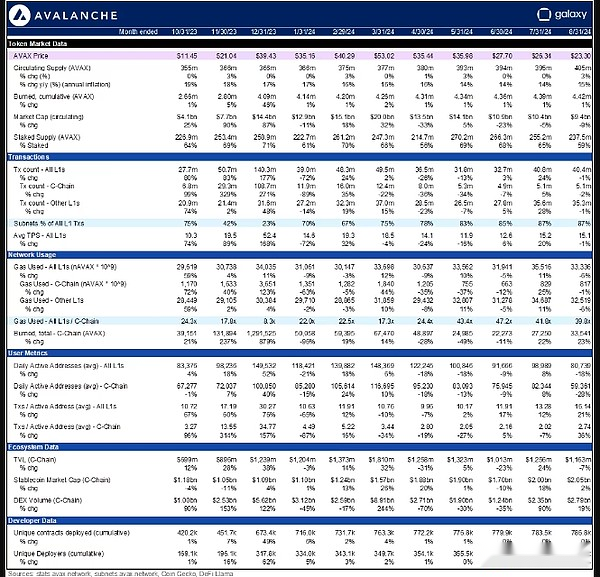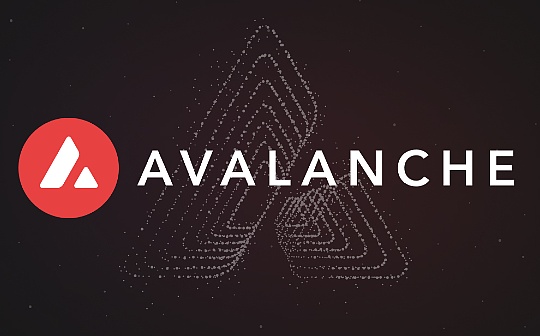
Author: Charles Yu, Galaxy; Compilation: Tao Zhu, Bitchain Vision
summary
Avalanche is a high-performance blockchain heterogeneous network.Avalanche’s prominent feature is its platform architecture, which uses a horizontal scaling method to build a multi-chain architecture with a highly customizable and interoperable blockchain called “L1” (formerly known as “subnet”).Customizability enables Avalanche to support a wide range of builders and use cases, especially across enterprise and institutional DeFi, for teams requiring privacy and access control, as well as gaming and consumer verticals.Avalanche’s mission is to “tokenize all assets in the world” and the powerful BD efforts have supported many well-known companies/organization efforts to move on-chain to explore innovative and influential crypto use cases on Avalanche.
Background information
The Avalanche mainnet was developed by Ava Labs and launched in September 2020 with high-performance EVM L1 (called “C-Chain”, the abbreviation of the contract chain), powered by an innovative consensus mechanism to achieve rapid transaction termination (usually<2 seconds).C-Chain’s adoption rate has grown rapidly, becoming one of the leading “EVM Alt-L1” for DeFi activity, attracting over $10 billion in TVL at its peak in 2021-22.
Since then, Ava Labs has been committed to distinguishing Avalanche from Ethereum and other EVM chains by focusing on the development of “subnets” to make it a more interoperable layer withCustomizable chains running in parallel with the main network.With a subnet launched in mid-2022, Avalanche provides developers with tools and capabilities that enable them to easily configure blockchain to best meet the needs of their users in a wide range of use cases – subnet builders on AvalancheYou can define execution logic, select your own gas token, adjust the fee structure, and manage the validator set of protection chains.The platform also enables native interoperability between blockchain and shared liquidity centers through Avalanche Warp Messaging/Teleporter.
Avalanche9000:The major planned network upgrade (through Etna upgrade) will replace the current subnet model with a new concept called “L1s”, which will significantly reduce the cost of launching blockchain on Avalanche.Specifically, Etna canceled the requirement for L1 validator to stake at least 1000 AVAX (reduced from 2000 AVAX in previous upgrades) and also canceled the requirement for verification of the main network (including C-chain).The new framework is designed to inspire subnets to accelerate and provide self-regulatory security for enterprise L1 to meet regulatory compliance requirements (especially for RWA issuers who are prohibited from verifying licenseless networks such as C-Chain).The Etna upgrade is scheduled to be deployed by the end of 2024.
Ecosystem highlights
Avalanche Ecosystem Growth Program/Marketing Program has targeted projects in DeFi, RWA/Tokenization, Gaming and Arts/Cultural End Markets:

Notable partnerships/project announcements related to Avalanche by end market include:
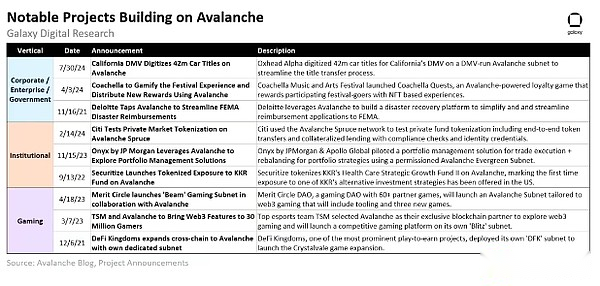
The subnet can be configured as public or private (i.e. blockchain data can only be provided to a group of managed validators).Here are some examples of public and private subnets:
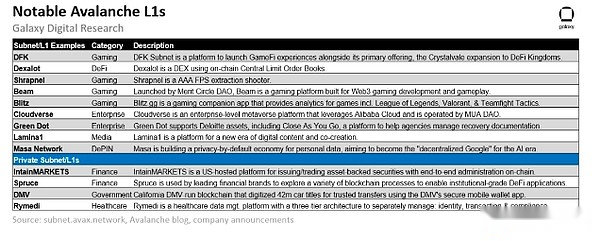
Of all L1s on the Avalanche network, two L1s (DeFi Kingdoms and Dexalot) have surpassed the C-chain in total Gas consumption and transaction count, demonstrating Avalanche’s scaling advantages.However, in terms of active addresses, the C-chain is still ahead of other L1s:
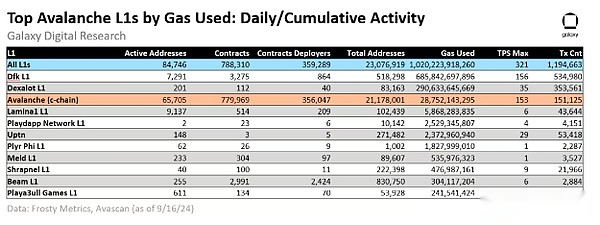
Basic indicators
Given the focus is on serving builders with custom subnets/L1s, the KPIs that evaluate the health of the Avalanche platform should include the main network and all L1s, such as: the number of L1s, total address and transactions, the total number of contracts deployed and contractsDeployer, maximum TPS, and total gas used by L1.
Avalanche Subnet/L1 Market Statistics:
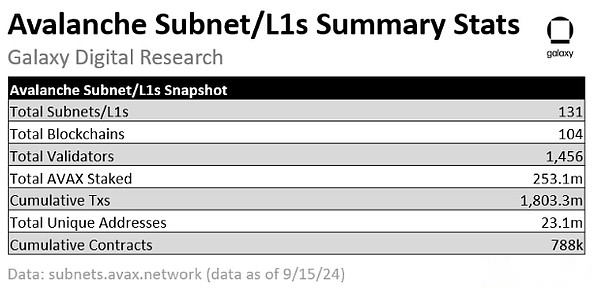

AVAX Tokens / Token Economics
Cost model:Avalanche C-chain fees (paid in AVAX) are based on Ethereum’s EIP-1559, including base and priority fees.However, transaction fees on the Avalanche C chain will be completely destroyed, including priority fees (unlike Ethereum, where priority fees are paid to validators, only the underlying fees will be destroyed).
Pledge:About 56% of AVAX’s circulation supply is pledged.Verifiers on the main network receive pledge rewards through issuance (current pledge rewards are approximately 7.9% APY).Verifiers of subnet/L1 may receive other forms of pledge rewards.
Attribution and Unlock:In the following year (September 9, 2024), 43 million AVAX (+10.6% in circulation supply) are planned to be unlocked.Except for the planned unlocking of 1.7 million AVAX every three months until 7/19/30, no other allocation will be unlocked in the future (i.e., as of 8/20/24, all groups except the Foundation (including teams andInvestors’ attribution unlocking has been completed).The pledge reward will continue to be unlocked linearly until 2030.
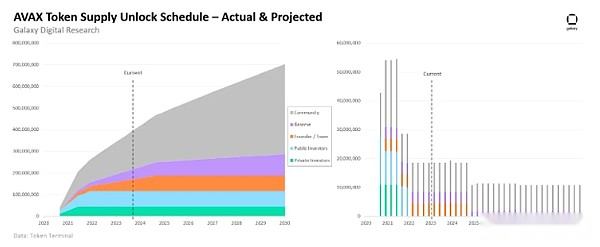
Competitive positioning
Competitors: The Avalanche platform and its subnets/L1 network The most relevant competitors include: Ethereum and L2, the Rollup ecosystem (such as Arbitrum Orbit, Optimism Superchain), Polygon Supernets and AggLayer, and interoperability platforms (such as Cosmos and Polkadot).These platforms are designed to provide builders with customizable features to launch application-specific blockchains, but each has its own unique web design:
Future challenges/opportunities:
-
Extend the subnet/L1 ecosystem.Past network upgrades and the upcoming Avalanche9000 program are designed to inspire the growth of Avalanche L1 by reducing setup/operation costs and introducing more customizable features to builders.Avalanche needs to attract quality projects and builders to its ecosystem while facing fierce competition from Ethereum L2, which is equipped with a powerful suite of development tools including Rollup-as-a-Service (“RaaS”) providers, which can help projects easily deploy application chains on the L2 platform.
-
Promote organization/enterprise adoption through licensed private subnet/L1.Licensed subnets have been positioned as a potential solution for regulated entities that need to meet certain compliance requirements (e.g., maintaining managed validator sets vs. licenseless verification).The Evergreen subnet solution is designed to serve TradFi entities for certain RWA/tokenized applications and is private by default.Currently, Ethereum is ahead of other networks in terms of regulatory acceptance, but as regulatory guidelines continue to evolve around blockchain’s privacy/control settings, Avalanche may gain recognition for its deep customization and hosting deployment in these areas.
-
Transform featured partner announcements into actual ongoing use.Avalanche has been involved with prominent partners in several promising proof of concepts, such as the disaster recovery spending at Deloitte x FEMA, tokenized car ownership at California DMV, and tokenized financial applications at JPMorgan or Citi.Moving these from POC to production will be the key to validating these use cases.
-
Showcase other core technical features of the platform.Ava Labs introduces tools for developers for custom VM development, including the HyperSDK toolkit, which has not yet launched its public development network.Most of the major public subnets/L1s currently exist utilize slightly modified EVMs (we haven’t seen Avalanche L1 with Solana’s SVM or MoveVM’s Avalanche L1 in production), but have HyperSDK and showcase a more powerful custom VM that can be used asAvalanche stands out from the characteristics of Ethereum and its L2 ecosystem.
Important events to be held
Some important upcoming events and expected time:
-
Avalanche Summit LATAM 2024 (16-18 October 2024)
-
Etna upgrade to Avalanche9000 (expected November/year end)
-
Shrapnel Game Early Access/Open Release (Expected 4th Q2024/1 Half of 2025)
Avalanche Summary Data
